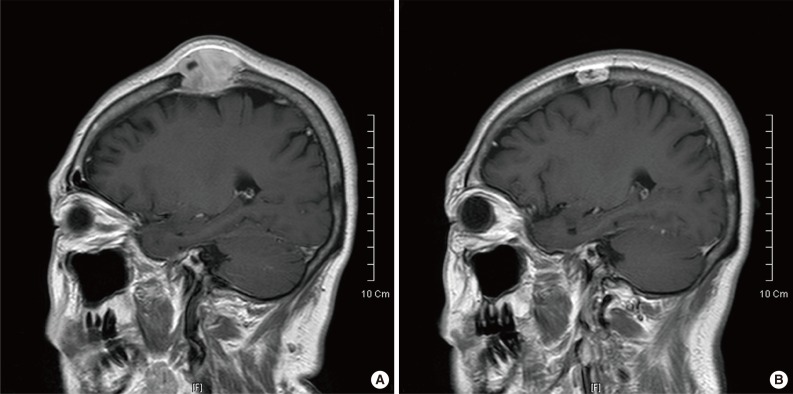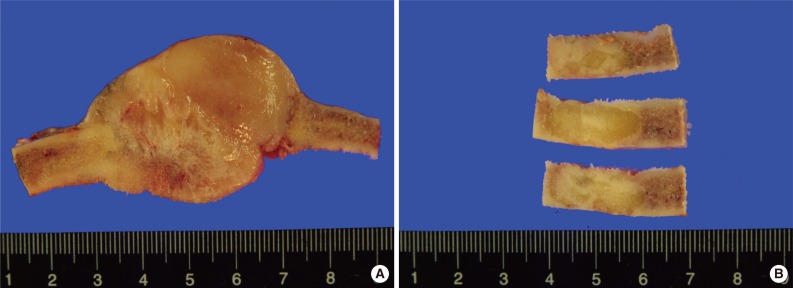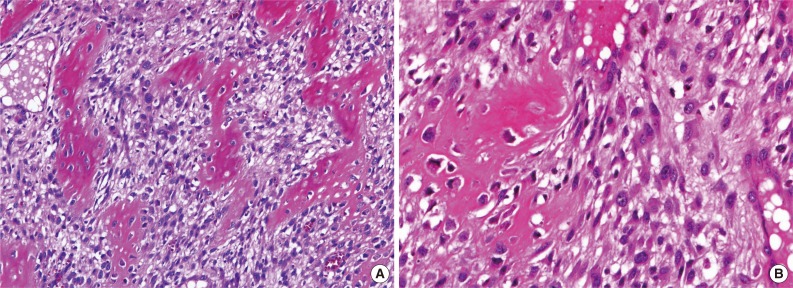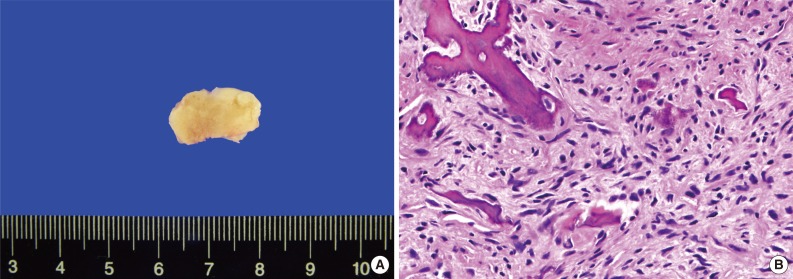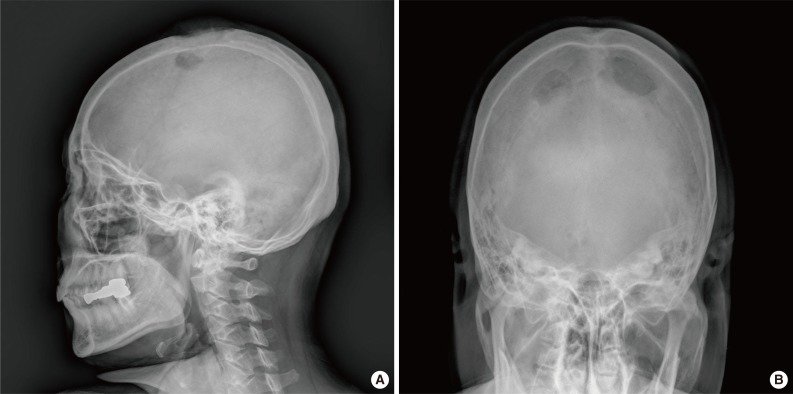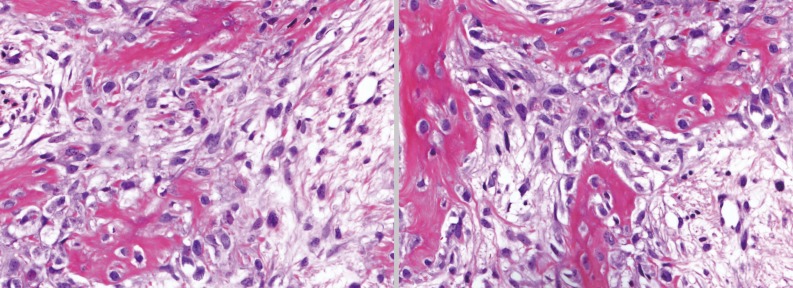Articles
- Page Path
- HOME > J Pathol Transl Med > Volume 48(2); 2014 > Article
-
Case Study
Multifocal Osteosarcoma of the Skull: Multiple Primary or Metastatic? A Case Report - Hyuck Cho, Bong-jin Park1, Yong-Koo Park
-
Korean Journal of Pathology 2014;48(2):146-150.
DOI: https://doi.org/10.4132/KoreanJPathol.2014.48.2.146
Published online: April 28, 2014
Department of Pathology, Kyung Hee Medical Center, Kyung Hee University College of Medicine, Seoul, Korea.
1Department Neurosurgery, Kyung Hee Medical Center, Kyung Hee University College of Medicine, Seoul, Korea.
- Corresponding Author: Yong-Koo Park, M.D. Department of Pathology, Kyung Hee Medical Center, Kyung Hee University College of Medicine, 26 Kyungheedae-ro, Dongdaemun-gu, Seoul 130-701, Korea. Tel: +82-2-958-8742, Fax: +82-2-957-0489, ykpark@khmc.or.kr
• Received: September 26, 2013 • Revised: November 17, 2013 • Accepted: November 25, 2013
© 2014 The Korean Society of Pathologists/The Korean Society for Cytopathology
This is an Open Access article distributed under the terms of the Creative Commons Attribution Non-Commercial License (http://creativecommons.org/licenses/by-nc/3.0/) which permits unrestricted non-commercial use, distribution, and reproduction in any medium, provided the original work is properly cited.
Figure & Data
References
Citations
Citations to this article as recorded by 

- A telomere-related signature for predicting prognosis and assessing immune microenvironment in osteosarcoma
Shihao Li, Lina Zhang, Haiyang Zhang
Frontiers in Pharmacology.2025;[Epub] CrossRef - Osteosarcoma multicéntrico sincrónico. Un caso en niño de 10 años y revisión de la literatura
Jesús Pérez-García, Osvaldo Velasco-Donado, Karoll Robles-Pérez
Revista Española de Patología.2022; 55: S11. CrossRef - Reconstruction using a frozen autograft for a skull and humeral lesion of synchronous multicentric osteosarcoma after undergoing successful neoadjuvant chemotherapy: a case report and review of the literature
Yoshihiro Araki, Katsuhiro Hayashi, Norio Yamamoto, Akihiko Takeuchi, Shinji Miwa, Kentaro Igarashi, Takashi Higuchi, Kensaku Abe, Yuta Taniguchi, Hirotaka Yonezawa, Sei Morinaga, Yohei Asano, Takayuki Nojima, Hiroyuki Tsuchiya
BMC Surgery.2021;[Epub] CrossRef - What’s that big thing on your head? Diagnosis of a large frontoparietal lesion on an Eastern Zhou skull from Henan, China
Kate Pechenkina, Wenquan Fan, Xiaodong Luo
International Journal of Paleopathology.2019; 26: 84. CrossRef - Kalvaryumda multifokal osteosarkom: Nadir bir vaka sunumu ve literatür derlemesi
Neslihan KURTUL, Nursel YURTTUTAN, A. Yasir BAHAR, Gökmen AKTAŞ
Kahramanmaraş Sütçü İmam Üniversitesi Tıp Fakültesi Dergisi.2019; 14(3): 151. CrossRef - Radiological review of skull lesions
Carrie K. Gomez, Scott R. Schiffman, Alok A. Bhatt
Insights into Imaging.2018; 9(5): 857. CrossRef - Multifocal Osteosarcoma
Somali Gavane, Anita P. Price, Heather Magnan, Sonia Mahajan, Neeta Pandit-Taskar
Clinical Nuclear Medicine.2017; 42(4): e202. CrossRef
 PubReader
PubReader ePub Link
ePub Link-
 Cite this Article
Cite this Article
- Cite this Article
-
- Close
- Download Citation
- Close
- Figure
Multifocal Osteosarcoma of the Skull: Multiple Primary or Metastatic? A Case Report






Fig. 1 Plain X-ray image of the mass. (A) Sagittal, simple X-ray image of the skull. (B) Town's view simple X-ray image of the skull.
Fig. 2 Magnetic resonance imaging (MRI) image of larger and smaller mass. (A) MRI image of the larger mass. Sequence 7/20. (B) MRI image of the smaller mass. Sequence 15/20.
Fig. 3 Gross image of larger and smaller mass. (A) Gross cross-sectional view of the larger mass. (B) Gross cross-sectional view of the smaller mass.
Fig. 4 Microscopic images of hematoxylin and eosin slides from larger mass. (A) Microscopic view of the larger mass. Round and spindle cells with moderate atypia are seen. (B) High power view of the larger mass. This area shows high grade osteosarcoma.
Fig. 5 Microscopic image of hematoxylin and eosin slide from the smaller mass.
Fig. 6 Gross image and microscopic image of hematoxylin and eosin slide from the metastatic mass in heart. (A) Gross view of the metastatic mass in the heart. (B) Microscopic view of the metastatic mass.
Fig. 1
Fig. 2
Fig. 3
Fig. 4
Fig. 5
Fig. 6
Multifocal Osteosarcoma of the Skull: Multiple Primary or Metastatic? A Case Report

 E-submission
E-submission

